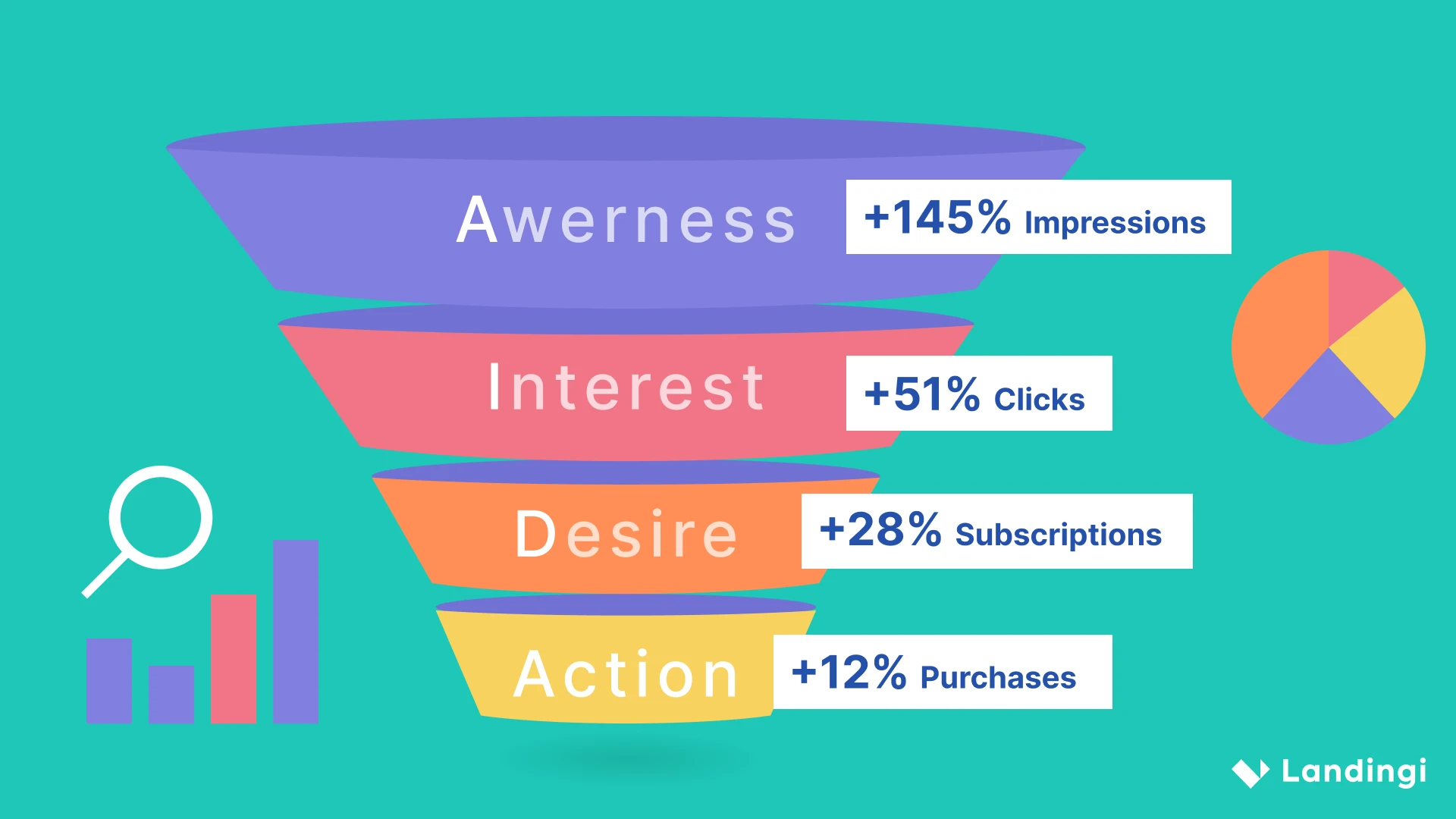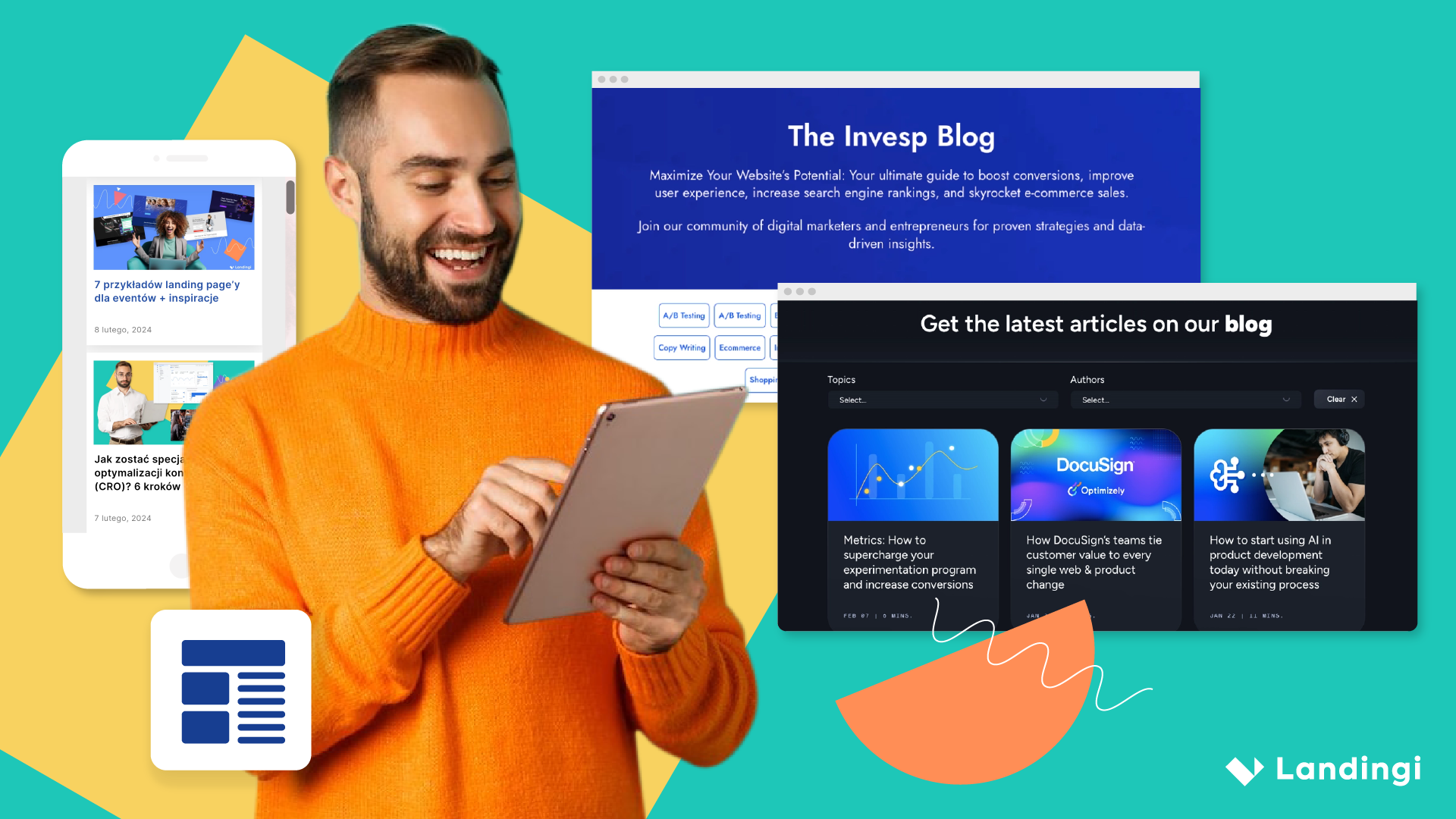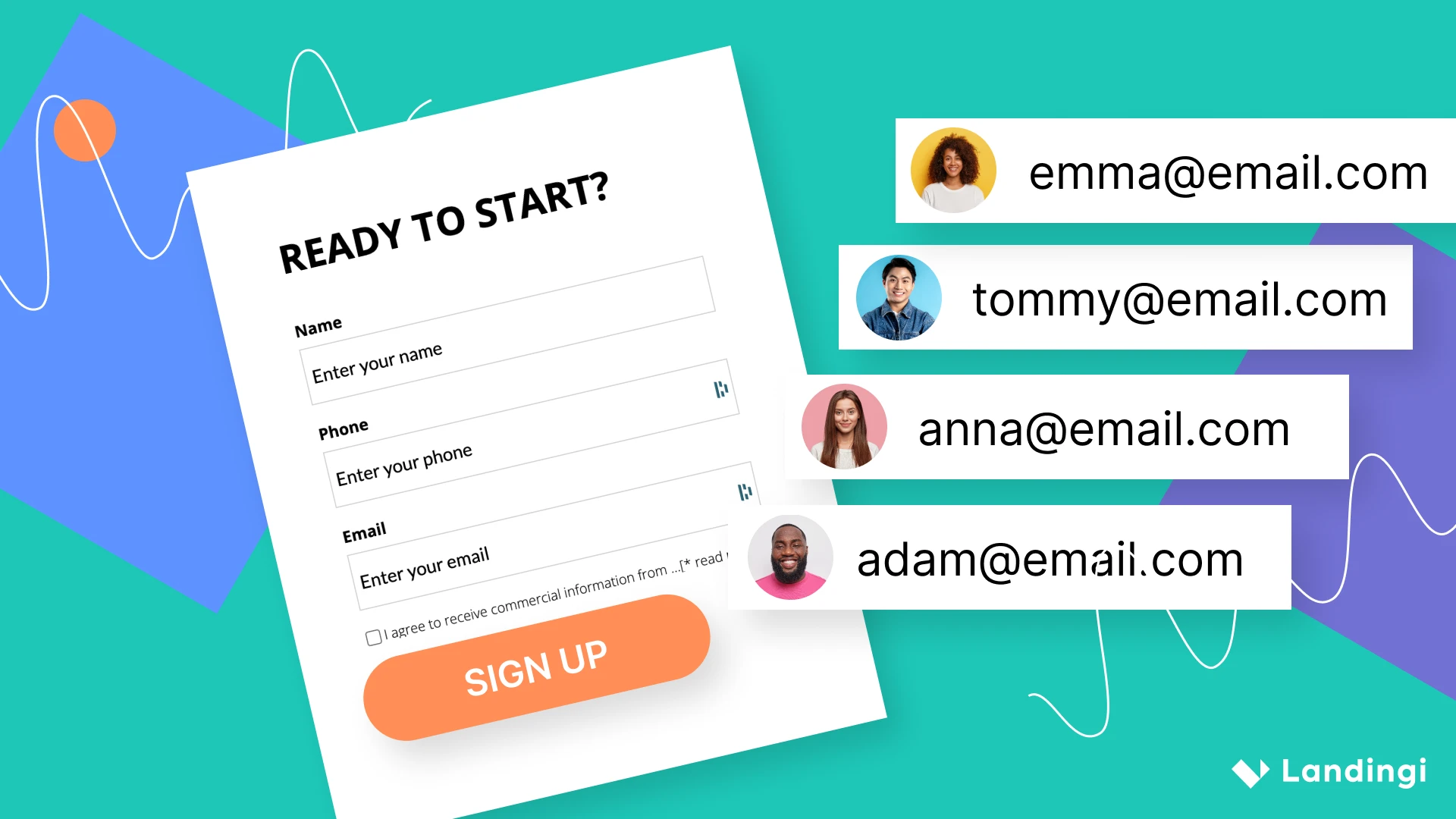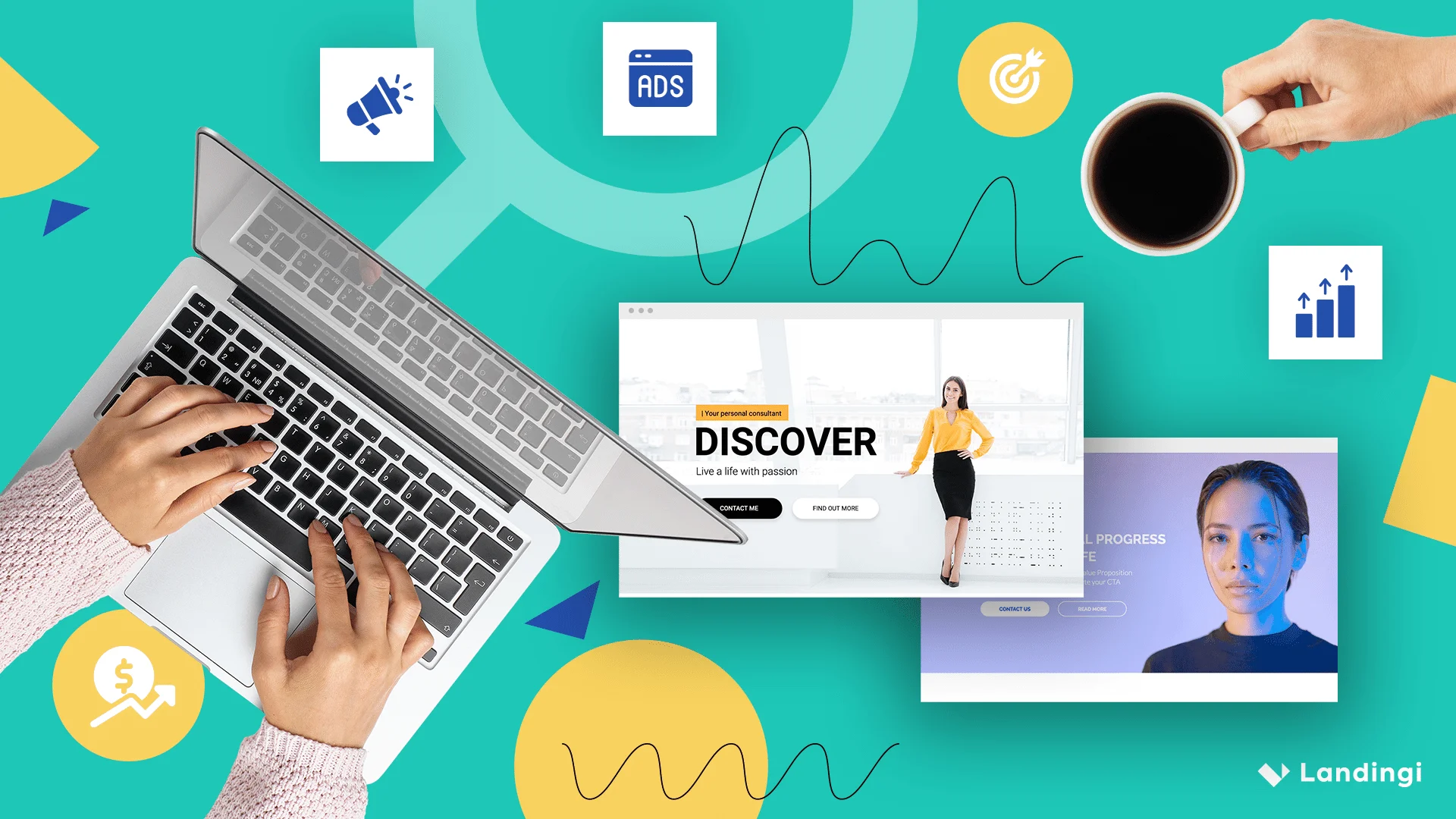In the highly competitive world of digital marketing, a strong sales funnel stands out as a guiding light, illuminating the way to success. Statistics show a path for those who believe in data-driven decision-making.
According to ZipDo, a well–defined sales funnel can lead to a 16% higher deal win rate, which should be a bright lightbulb for your strategic thinking. However, a well-prepared funnel means too little for marketing strategies without a proper analysis run regularly with deep insights into data and implementation of optimization processes.
With this post, you will learn more about conversion funnel analysis and see examples for three various business areas.
Make your sections smartable and let go of mundane manual tasks with Smart Sections! An easy way to manage bulk changes.
How to make Funnel Analysis in 10 Steps?
To make a funnel analysis and examine the specific steps your traffic takes within a conversion funnel, e.g., where they drop off or where they convert, take the 10 following steps:
- Define Funnel Stages
- Choose Analytics Tool
- Identify Key Metrics
- Collect Data
- Create a Funnel Visualization
- Analyze Conversion Rates
- Identify Bottlenecks
- Find Optimization Areas
- Implement A/B Testing
- Report Insights
To get more details about analysis flow, take a look at the specific explanation for each of the ten mentioned steps:
Step #1 Define Funnel Stages
Firstly, typify the stages of your funnel and clearly outline the steps or stages that users go through to complete the desired action. You have to understand that defining your funnel stages is essential when preparing a conversion funnel that provides valuable data about your traffic behavior.
Funnel Stages can vary, depending on your business model, but the basic path always looks similar to the following one:
- Visiting the webpage,
- Viewing product/content,
- Taking the desired action,
- Initiating checkout/form filling,
- Completing purchase/registration.
Once you define your funnel with appropriate points, you get a projection of perfect user behavior, which you can measure and analyze.
Step #2 Choose Analytics Tool
Secondly, you have to choose adequate funnel analysis tools, e.g., Google Analytics or Landingi, that allow you to gain significant data and simplify the process of your conversion analysis.
At this step, ensure that data tracking is implemented correctly on your website, landing pages, or application.
Step #3 Identify Key Metrics
The third step is to find key metrics for each of your conversion funnel stages and ensure they provide essential information needed to run the analysis properly, e.g.:
- For the 1st stage – visiting a website, the key metric would be Visits (the number of Internet users that visit your page)
- For the 2nd stage – viewing product/content, the key metric would be Views (the number of product/content page views)
- For the 3rd stage – taking the desired action, the key metric would be Micro-conversion for each CTA (the number of CTA clicks)
- For the 4th stage – initiating checkout/form filling, the key metric would be Cart Additions/Form Openings (the number of users who start purchasing or registration process)
- For the 5th stage – completing purchase/registration, the key metric would be Conversion (the number of completed purchases/registrations)
Step #4 Collect Data
The fourth step in conversion funnel analysis is to let the chosen tool work in time to collect significant data. It may take weeks or months to gather sufficient information for research, but that depends on the strategy you have taken for your digital marketing actions.
Note that when marketing strategy operates on timelines, you shouldn’t worry about mid-results, which appear daily, but trust the process and wait for the final data.
Step #5 Create a Funnel Visualization
In the fifth step, once the data is collected, it’s time to use your analytics tool and create your conversion funnel visualization, which will help you quickly and aptly identify the drop–off areas you can improve.
Most widely known analytics platforms provide a funnel and data visualization feature, so you and your team don’t waste time on unnecessary, time-consuming processes.
Step #6 Analyze Conversion Rates
In the sixth step, it’s time to analyze your conversion rates and calculate results for each stage of the funnel in order to understand where users are dropping off and where improvements can be made.
A comprehensive analysis of conversion rates is the foremost step in the process of understanding your potential customers’ behavior and your website’s weaknesses.
But don’t worry; there are always some weak points in the conversion path, and once you figure out where they appear, you gain space for optimization, adaptation to new trends, and improvement of the user experience factor.
To better understand where and how weaknesses appear, follow the detailed analysis steps below.
Step #7 Identify Bottlenecks
In the seventh step, after examining the general analysis of critical metrics, pay attention to these stages, which show high drop-off factors, and try to find potential issues that may cause poor results. The common issues include three frequently appearing mistakes:
- Confusing Navigation refers to the user experience issue and goes with complex or confusing page structure, e.g., mobile responsiveness issues, unclear menu structure, or overly complex dropdown lists.
- Long Forms, a significant obstacle impacting user progression through the conversion journey, can be perceived as a potential invasion of the user’s privacy, often taken as a time-consuming burden.
- Unclear CTAs, which fail to convey the intended action or lack clarity in guiding users on what steps to take next, refer to common problems e.g., enigmatic language, lack of context, or poor design.
Step #8 Find Optimization Areas
The eighth step guides you to examine weak points to find solutions and then implement relevant optimizations, aiming to fix the most problematic spots on your webpage or application, e.g., detecting unclear CTAs, inserting changes, and, as a result, simplifying the conversion process.
Step #9 Implement A/B Testing
In the following ninth step, implement A/B testing to experiment with changes you decide to make on your website or in your application. You can test different page design variations, button projects, or forms to see how they impact the conversion rates at each stage and then at the final conversion.
According to Invesp, about 58% of businesses use the A/B testing method for conversion rate optimization – its popularity shows how beneficial split tests are to boosting conversion results.
Step #10 Report Insights
The tenth step, last but not least, is about new report insights – remember to generate new data statements after implementing changes to check out how your optimization affects the user journey on your website. Share insights with your marketing team and draw conclusions, preparing new optimization ideas.
Conversion funnel analysis is a wheel that constantly spins in every well-prospering business – take it as great advice for the future and repeat the process to ensure that your optimization efforts will bring the ultimate goal – boost conversion.
Get 111 Landing Page Examples—The Ultimate Guide for FREE
3 Examples of Conversion Funnel Analysis
To clearly understand what a conversion funnel analysis is and how its optimization affects your business, check out the 3 hypothetical examples of funnel analysis reports with explanations.
#1 Conversion Funnel Analysis for e-Commerce
The first example shows the effective conversion funnel for sales and explains why conversion funnel optimization in eCommerce changes the game.
For the hypothetical mid-sized online store, the user journey will follow: visiting the website → navigating to the eStore → adding products to the cart → initiating checkout → filling out the form → completing the transaction. Let’s design an example conversion funnel for e-commerce with these stages. Each stage includes a count of users that reached it on their customer journeys. Here is what our exemplary funnel may look like:
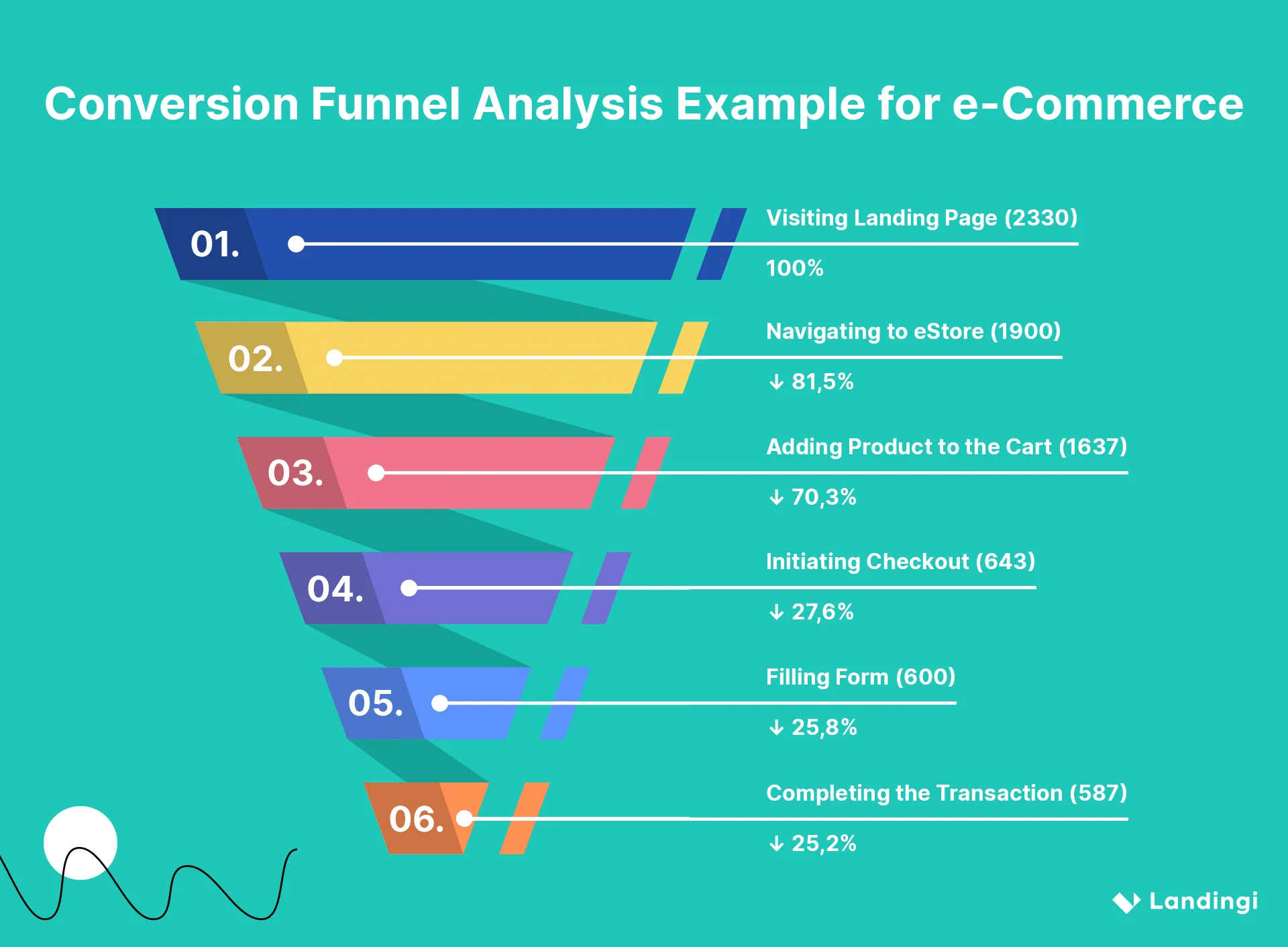
The initial metric in this example is the number of landing page visitors, which is taken as 100%. As you can see in the picture above, each stage of the conversion funnel shows drop-offs. It’s normal, but you’re looking for weak spots which can be improved.
In this case, you can notice the most significant drop-off appears in step 4. of the user’s journey: Initiating Checkout.
Only 39% of users of those who have completed the previous step and barely 27.6% of all landing page visitors have taken the desired action, which means the most problematic area for this business is Initiating Checkout.
The solution, in this case, will be optimizing the process from adding products to the cart to initiating checkout. It may include design changes, adding popups, or implementing email reminders about abandoned carts for visitors with store accounts.
Split tests for each optimization will show results on detailed funnels – when sales conversion rates for A/B tests differ, the only profitable solution is to leave the version with a better score and let conversion grow.
#2 Conversion Funnel Analysis for SaaS Product
The SaaS conversion funnel is more complicated example, where stages differ from typical eCommerce funnel stages and are based on David McClure’s AARRR Pirate Metrics, invented in 2007, with one change – while the original version of Pirate Metrics has 5 stages, the SaaS adaptation shows one more A–stage and operates on:
- Acquisition – refers to the signs up for a free or demo version of a SaaS product,
- Activation – relates to the users’ engagement with your SaaS product’s essential features,
- Adoption – refers to the existing customers’ decision to adopt your SaaS product for the long term,
- Retention – refers to the extension of the previous stage and entails ensuring that users not only make an initial purchase but also continue using and paying for your product over an extended period,
- Referral – refers to the changing users into your SaaS product advocates and starting the product recommendation process,
- Revenue – refers to generating higher revenue through account expansion (within e.g. upselling, cross-selling, add-ons, etc.).
As the SaaS conversion funnel is way more complex than a basic sales funnel, analysis can be challenging. The important step, in this case, is to create an appropriate metric set for each stage of the funnel to measure success within every part of the user journey.
Analysis of conversion SaaS funnel can include such metrics as:
1. For Acquisition Stage:
- Sign-up rate – the number of visitors who decided to sign up for a free trial of your product over a set period
- Demo requests rate – number of visitors who requested your products’ demo over a set period
- PQLs (Product-Qualified Leads) – number of users who have experienced your products’ value
2. For Activation Stage:
- Onboarding completion rate – number of users who start and finish the onboarding process
- Customer activation rate – the percentage of customers that activate or understand the value of your product
- Time to Value – the metric of time taken by the user to discover the value of your product
3. For Adoption Stage:
- TTA (Time to adopt) – average time taken by users to reach adoption
- Feature adoption rate – the percentage of users who adopt a core product feature
- BoU (The breadth of use) – number of users per account
- DoU (Depth of use) – number of core product areas your customers use your product
4. For Retention Stage:
- Customer retention rate – the percentage of existing customers who remain over a set period.
- Customer churn rate – the percentage of customers who cancel their subscriptions over a set period
5. For Referral Stage:
- Customer satisfaction score – number of positive answers in satisfaction surveys
- NPS (Net Promoter Score) – the number of your customers willing to promote your product/service
6. For Revenue Stage:
- CLV (Customer lifetime value) – the total amount a customer is expected to spend on your product through the lifetime of your business relationship
- ARPU (Average revenue per user) – the amount a company expects to generate from each customer over a set period
- ARR (Annual recurring revenue) – the projected revenue from subscriptions and other recurrent contracts over a year
Take a look at a projection of a hypothetical SaaS conversion funnel analysis example with a user journey path including 6 steps: registration for a free trial → onboarding completion → the core product feature adoption → payment for the first-month subscription → filling satisfaction surveys → payment for an extended subscription. Remember: the higher the stage, the fewer visitors that reach it. With this in mind, our funnel might look like this:
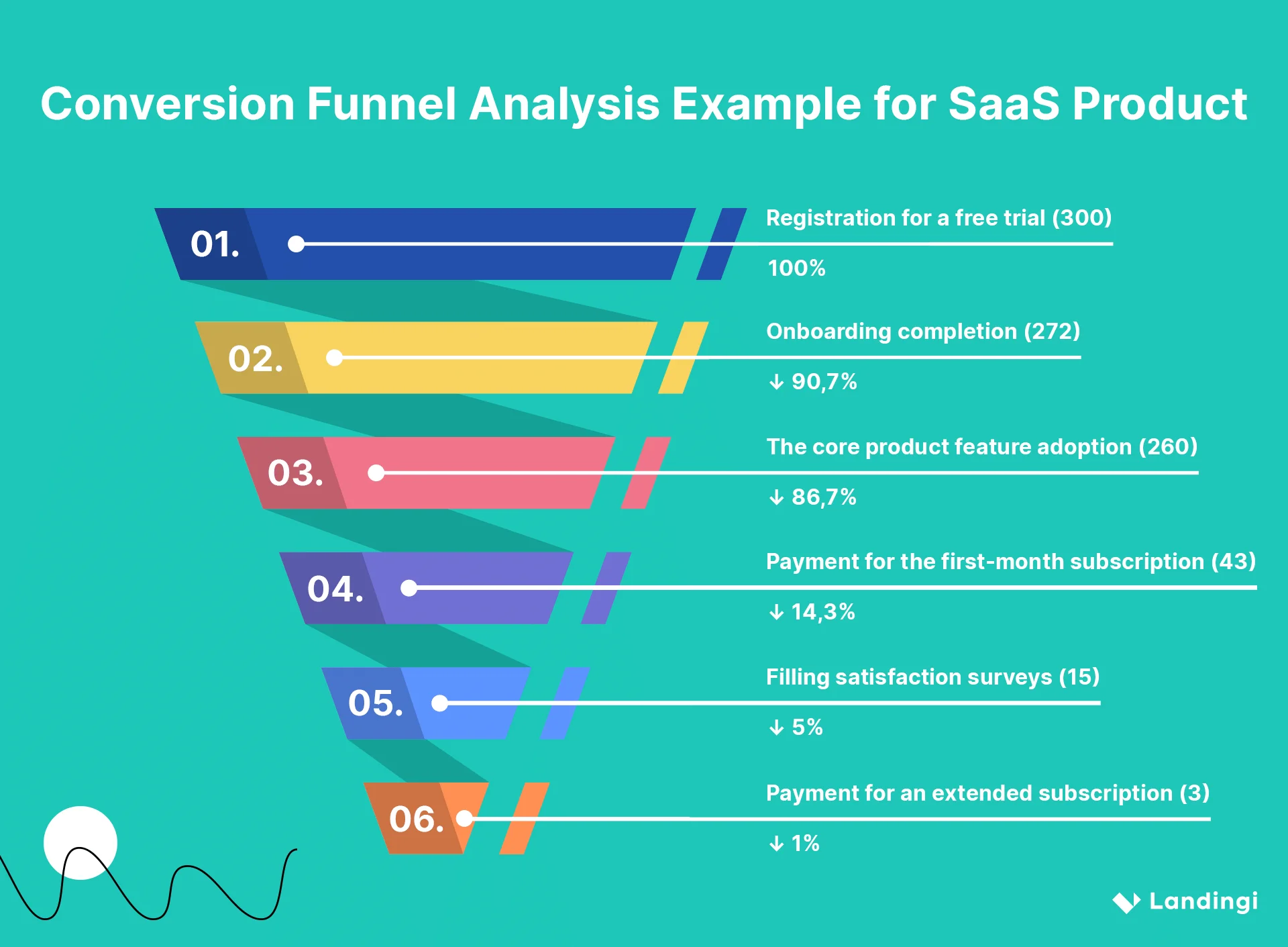
The final conversion rate for this funnel is barely 1%, but if you take a look, according to step 4, when users decide to pay for a first-month subscription, the conversion rate would be 7%. It means that of all users who chose to try a full version of the SaaS product, 7% considered it good enough to pay for the extended subscription.
The highest drop-off, in this case, appears between the 3rd and 4th steps, which refers to the adoption stage of a funnel.
To fully understand the issue and find the causes of such a huge drop-off, the team should examine funnel reports within each metric set at the 3rd and 4th stages: TTA, feature adoption rate, BoU, DoU, churn rate, and retention rate. Tracking events and deep analysis of metrics would help to find optimization areas.
#3 Conversion Funnel Analysis for Marketing
The last example shows the conversion funnel analysis for marketing with an explanation of marketing funnel characteristics.
A marketing funnel visually represents the customer’s journey through your business, from initial acquisition to eventual advocacy. This model encapsulates various levels of user interaction and engagement with your company.
Before you dive into an example, note that sales and marketing are closely intertwined, as one significantly influences the other. Your marketing efforts play a key role in driving sales growth, highlighting the sales funnel as an integral component within the broader marketing funnel framework.
The marketing funnel consists 5 key stages:
- Awareness stage – refers to the brand-building area and shows the point at which potential customers meet your product or service for the first time. The key metric at this stage is, e.g., the number of ad clicks or blog post views.
- Consideration stage – refers to your target customer’s higher interest and willingness to try out your product or service. The key metric at this stage is, e.g., the number of newsletter sign-ups or webinar requests.
- Conversion stage – refers to the lead’s decision-making. At the point of engagement in your product or service, the key metric at this stage is e.g., conversion from free service to paid service.
- Retention stage – refers to meeting or exceeding your actual customer’s expectations. The key metric at this stage is e.g. retention rate or CLV.
- Loyalty stage – refers to the value of your product or service. The key metric at this stage is, e.g., the number of given recommendations or net promoter score.
Take a look at the hypothetical projection of the marketing company’s conversion funnel analysis with a customer journey map that includes 5 steps: social media ad click → webinar request → booking paid consultation → purchase of monthly consultations in the annual subscription → recommendations. In this case, hypothetical metrics for the following stages might be depicted this way:
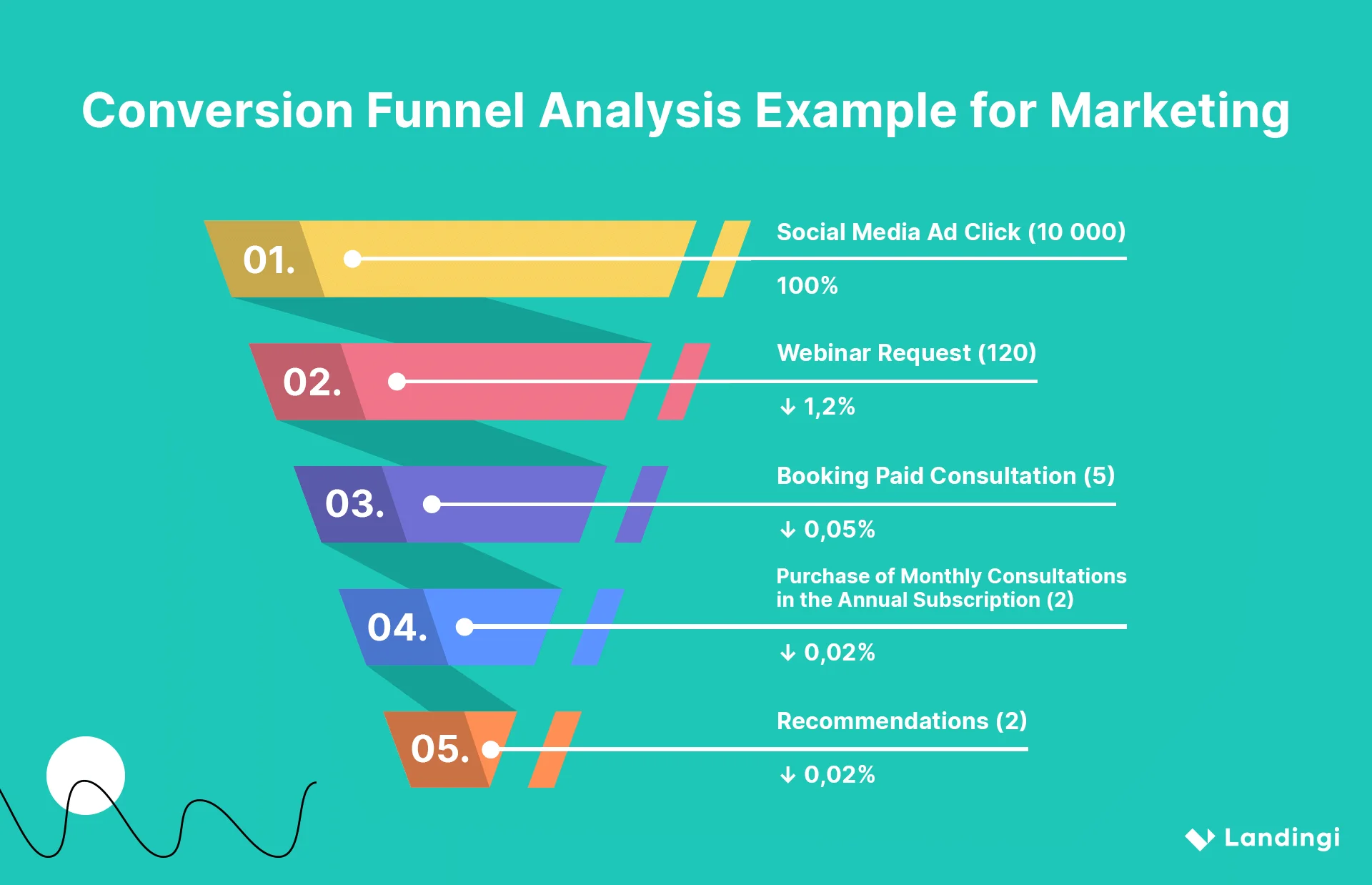
The picture above shows how difficult it can be to reach the final conversion rate on a high level within social media advertising. However, the point, in this case, can be converting warm traffic (from the consideration stage) to hot traffic (to the conversion stage) because the company already knows that retention and loyalty stages are well-prospering ones – from all users who decided to book paid consultation, 40% bought an annual subscription, and 100% of those given a recommendation.
While the highest drop-off score appears between the 1st and 2nd stages, more important can be the significant drop-off from webinar requests to booking paid consultations.
Of course, dependency goes with the ROAS factor in this case, but looking closely at the conversion from the 2nd to the 3rd stage would be crucial. The causes of such situations may differ:
- some users request webinars randomly,
- some forget about them,
- some take part in events but don’t click CTAs, etc.
There is a space for optimization in order to maximize conversions.
What to Avoid in conversion Funnel Analysis?
In the conversion funnel analysis process, there are 7 pitfalls that can poorly affect clear and meaningful insights:
#1 Overlooking Micro-Conversions
Focusing solely on your end goals (macro conversions) and neglecting intermediate stages (micro-conversions) can result in a lack of understanding of the user’s behavior at different stages of the funnel.
It is essential always to consider the importance of minor actions that contribute to the overall conversion process.
#2 Ignoring User Segmentation
Lack of audience segmentation can mask essential differences in user behavior. Different user segments may have various needs and preferences.
It’s crucial to analyze your conversion funnel for different demographics, sources, or user characteristics.
#3 Relying Solely on Averages
Averaging conversion rates across the funnel can blur valuable information.
Analyze conversion rates at each stage independently to identify specific pain points, bottlenecks, and areas ready for improvement.
#4 Focusing Only on Successful Conversions
Don’t just focus on completed conversions, but also analyze the behavior of users who did not convert.
Understanding the reasons and points where users drop off provides valuable insight into potential issues and optimization opportunities.
#5 Ignoring Seasonal or External Factors
External factors, e.g., holidays or special events, can affect user behavior. Ignoring these factors can lead to misinterpretation of data.
Remember always to consider context and external influences when analyzing your conversion funnel.
#6 Lack of Regular Analysis
Conversion funnel analysis should be an ongoing process, as a spinning wheel that comes back to the initial factors and takes a look at the improvements’ performance, implementing new optimization strategies over and over.
Neglecting regular reviews and updates can result in outdated insights. While optimizing your conversion funnel, you must adapt to changes in user behavior and market dynamics.
#7 Rushing to Solutions Without Root Cause Analysis
Once problems are identified, thoroughly understand the root causes before attempting to implement quick fixes. Each time it comes to analysis, run a comprehensive root cause analysis to address the underlying problems effectively.
FAQ About Conversion Funnel Analysis
To fully understand the meaning of conversion funnel analysis, check out a shortlist of 6 frequently asked questions and ensure your knowledge is updated:
What is funnel analysis?
Funnel analysis is all about tracking and analyzing user interactions through stages of a user‘s journey process within a website or app to identify and optimize it for conversions. Analysis of the conversion funnel provides insights into user behavior, drop-off points, and areas for improvement in the conversion journey.
What is a funnel strategy?
Funnel strategy represents a systematic approach to guiding users through the stages of the conversion process. It includes targeted actions, messages, and optimizations at each stage to maximize conversions, typically used in sales, marketing, or user engagement scenarios.
What is a funnel report?
A funnel report is a database of user interactions at various stages of a conversion process, often represented visually with an automated funnel analysis tool.
It shows critical metrics e.g., conversion rates, drop-offs, and key performance indicators, providing insights for businesses to analyze and optimize their funnel for higher revenue.
Why you should perform conversion funnel analysis?
Performing conversion funnel analysis is necessary for the 5 following advantages:
- Identifying issues and showing pinpoints where users drop off,
- Optimizing user experience,
- Increasing conversions,
- Maximizing ROI,
- Continuous Improvement, tailored to user behavior or market changes.
What is Conversion Rate Optimization?
Conversion Rate Optimization (CRO) is the process of enhancing a website or app to increase the percentage of visitors who complete desired actions, e.g. sign up for free trials, request demo versions, etc.
The process involves data analysis, A/B testing, and iterative improvements to maximize user conversions.
What are the best funnel analysis tools?
The best funnel analysis tools are these, which offer a maximum of functionalities with possibly user-friendly interfaces, such as Landingi – the best digital marketing tool, which provides, among others, an Event-Tracker solution with features that allow you to track user behavior and examine click patterns or user trends within your webpage.
Because of its multifunctional attitude, Landingi is the best conversion optimization tool, providing the most valuable solutions, e.g., split test tool, for improving data-driven marketing campaigns’ efficiency.
Key Takeaways: Why, when, and how to run Conversion Funnel Analysis?
Conversion funnel analysis is a crucial process for any data-driven marketing strategy and, at the same, the necessary step in the conversion rate optimization process. To run a professional funnel analysis, you should:
- Design appropriate funnel stages for your current goals,
- Find tools tailored to your business needs,
- Choose the right metrics,
- Collect data and examine them to find pain points,
- Implement optimization and repeat analysis regularly to maximize conversion.
At this point, you know exactly how to create your funnel and what steps you should take – if you struggle with choosing the right tool, check out the free trial of the most efficient digital marketing tool – Landingi, and let yourself achieve success with an effortless solution for conversion funnel analysis.

